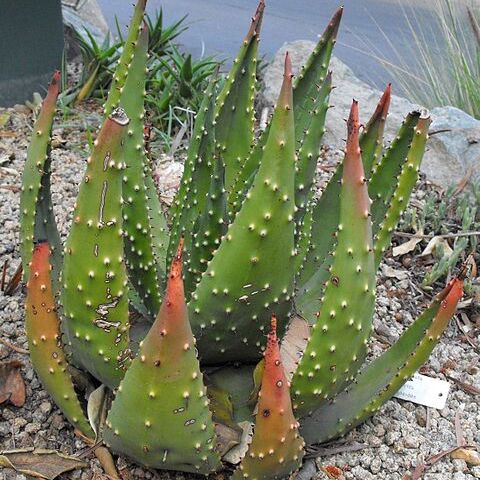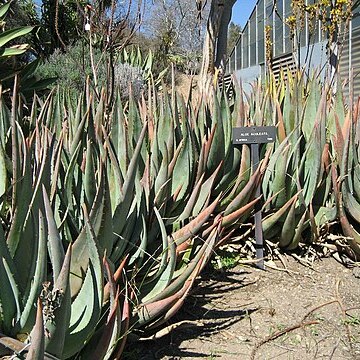Stem usually short, sometimes as much as 1 metre in height, unbranched. Leaves numerous, in a dense rosette, erect-incurved, lanceolate-ensiform, distinctly attenuated, terminating in a sharp thorn, 45-60 cm long, and 7.5-11 cm broad at the base, 15-17 mm thick, the margins beset with conical reddish-brown thorns 5-6 mm long and 10-20 mm apart, somewhat concave above, channelled towards the apex and with a few similar thorns especially in the median line, convex below and more thickly studded with thorns. Peduncle stout, simple or branched, laterally compressed, clothed with numerous broad deltoid bracts, usually 2-5 branches, arcuate-erect; racemes 30-60 cm long and about 7 cm broad, clothed at the base with dry empty scariose bracts, dense, many-flowered, upper part of raceme with unopened buds bright orange-scarlet; bracts maroon-claret brown (R.C.S.), deltoid-acute 11 mm long, and 7-8 mm broad; pedicels 3 mm long. Perianth 34-38 mm long, cylindrical-ventricose, lemon-yellow (R.C.S.); outer segments united for 14-16 mm from the base, linear-lanceolate, with 3 green or orange veins and tipped with brown, inner segments lighter in colour, more obtuse with chestnut-brown tips. Stamens and style protruding 15-17 mm beyond the perianth, filaments stout, coloured auburn (R.C.S.); anthers bright orange chrome (R.C.S.), dark brown at the back, style lemon-yellow. Capsule cylindrical trigonous, 14-18 mm long and 8-10 mm diam., greyish; seeds triquetrous, narrowly winged dark, 4 mm long.
Plants stemless, 300-600 mm tall excluding inflorescence, solitary. Leaves ±30, 250-600 x 50-120 mm, shallowly channelled, grass-green to glaucous, upper surface with few prickles, lower surface with many prickles, these on both surfaces scattered, dark brown, arising from white tubercles. Inflorescence of erect, cylindric, very dense racemes, 2-4-branched, ±1 m tall; bracts ovate-acuminate, 6-10 x 4-7 mm, many-nerved. Flowers reddish orange to yellow in bud, orange to yellow at flowering, 23-40 mm long, mouth straight; outer segments connate for less than half their length, inner segments free; pedicels 2-7 mm long. Anthers exserted 7-15 mm. Ovary 4.0-6.0 x 1.5-3.0 mm, green; style exserted 7-18 mm. Fruit ±18-10 mm. Flowering time (May to) June to August.
Leaves in a dense rosette, erect and often slightly incurved; lamina 30–60 cm long, 9–14 cm wide toward the base, ovate-lanceolate, greyish-green, bronzed in dry conditions, with scattered reddish-brown prickles from a pale circular base on the lower surface and usually near the apex of the upper surface, otherwise unmarked; margin with pungent, reddish-brown deltoid teeth 3–4 mm long and 10–15 mm apart.
Perianth bright red in bud rapidly turning orange to greenish-yellow on opening, 28–35 mm long, c. 7 mm in diameter across the ovary, widening to c. 10 mm at the middle and narrowing slightly toward the mouth, cylindric; outer segments free for two-thirds with tips slightly spreading.
Acaulescent, succulent herb, up to 0.6 m high, excluding inflorescence. Leaves with random surface prickles throughout. Inflorescence ± 1 m high. Racemes erect, cylindrical, very dense. Flowers reddish orange to yellow in bud, orange to yellow at anthesis.
Inflorescence erect to 1.25 m high; peduncle simple or 1–3-branched; branches erect, subtended by deltoid scarious bracts c. 12 × 12 mm, with scattered sterile bracts below the racemes.
An aloe. It is a herb without a stem. The leaves are in a ring. They are 30-60 cm long and 9-14 cm wide near the base. They have reddish-brown prickles.
Racemes 20–50 × 7 cm, cylindric, very densely flowered; bracts 10–15 × 5–6 mm, ovate, scarious, brownish, strongly deflexed; pedicels c. 2 mm long.
Stamens and stigma exserted c. 15 mm; stamens with purple-tinged orange filaments and reddish-orange anthers; stigma pale orange.
Perennial herb, solitary, acaulescent.
Capsule and seeds not seen.


